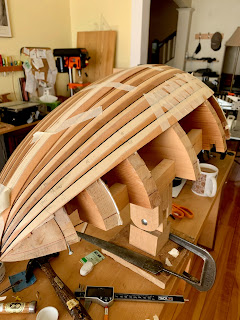My newest archlute is packed and ready for the flight to San Francisco. I have stuffed bubble wrap in the empty spaces around the lute to immobilize it. An additional layer of bubble wrap will be laid on top. Needless to say, all tension has been released from the strings. Not in the picture is the shipping box that I constructed. It is assembled from two inch thick styrofoam insulation sheets glued together so that the case fits tightly inside. This construction is then covered with heavy cardboard that I savage from shipping boxes and glued to the styrofoam with styrofoam adhesive.
Obviously, I worry a lot about shipping instruments and I try to convince clients to pick up their new instruments. That is not often possible, as with this lute. Formerly, I delivered lutes myself, driving to New York, Virginia or Bloomington and Ann Arbor and many places in between. But now-a- days I stay close to home.
The lute is a model of E.25, an anonymous archlute conserved in Musée de la musique, Paris. The original lute is large with a fretted string length of 71cm. Its diapason are 109 cm. I built the first model in 2000 as a close copy. But I never built an archlute of that model until now. In the meantime it has served very welI as the basis for baroque lutes. I have used the bowl design and soundboard lay-out for many, building models with swan-necks, bass riders or triple nuts. All perform admirably.
The fretted string length of this lute is 68.5 cm.
The diapason length is 130 cm.
The width of the soundboard is 33.8 cm.
The length of the soundboard is 47.1 cm from the tail to the neck joint.
When I examined the lute in Paris in February 2000 curator Joël Dugot told me that the lute, meaning the bowl and soundboard, was a very close match to Hans Burkholtzer's thirteen course lute in Künsthistorisches Museum. And indeed it it. The profile of the top, the cross-sectional arch of the back and the placement of the bridge and rose on the soundboard are proportionally the same. Both lutes bowls are assembled with ivory ribs and dark spacers. The Burkholtzer has 21 ribs while E.25 has seventeen. E.25 is a few millimeters smaller.
I chose to use 21 ribs because my stock of striped yew was not wide enough to achieve the width required for 17 ribs.
You can read more about the similarities in my blog from February 21, 2016. Enter E.25 in the Search Box.
The striped yew ribs are separated by thin ebony spacers on the same open mold that I used since 2000.
Striped yew can be difficult to use because it it necessary to choose pieces that will equally display heartwood and sap in an attraction symmetrical fashion. Finished lute ribs are never symmetric, however, meaning that the centre line between the prepared edges is never straight but curves more or less gradually. If a rib in prepared from straight stock with equal parts of heart and sap wood there is the danger that either one or the other will be cut away as the rib narrows towards either end - as happened here.
The end clasp is composed of two pieces separated by an ebony spacer.
In this view the heart wood and sap wood are proportionally equal from rib to rib.
The neck core is sitka spruce veneered with Claro walnut edged with ebony.
The instrument has nine tied frets. The ninth sits so close to the neck joint that I inserted a small button and loop the fret over it to prevent the fret from sliding up the neck. I like this arrangement rather than using a wood fret at a similar location.
The neck joint is 10 cm wide and the thickness of the neck at this point is 30 mm.
Since the extension is only 75cm long I decided to make it out of a solid piece of English walnut. The piece has a small regular curl.
The extension head is carved from walnut too. The design of the head is inspired by the one from the Tieffenbrucker archlute C.45, KHM.







.jpeg)




